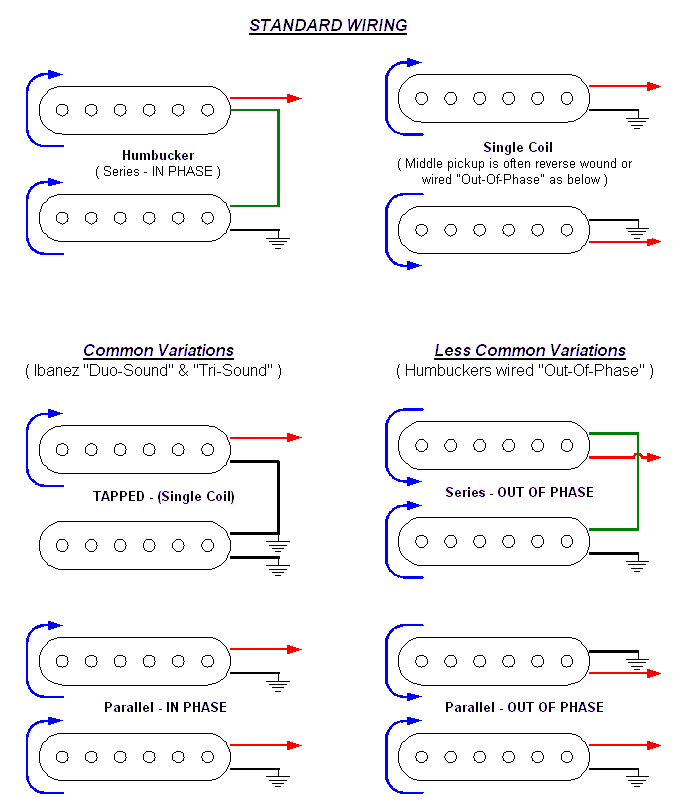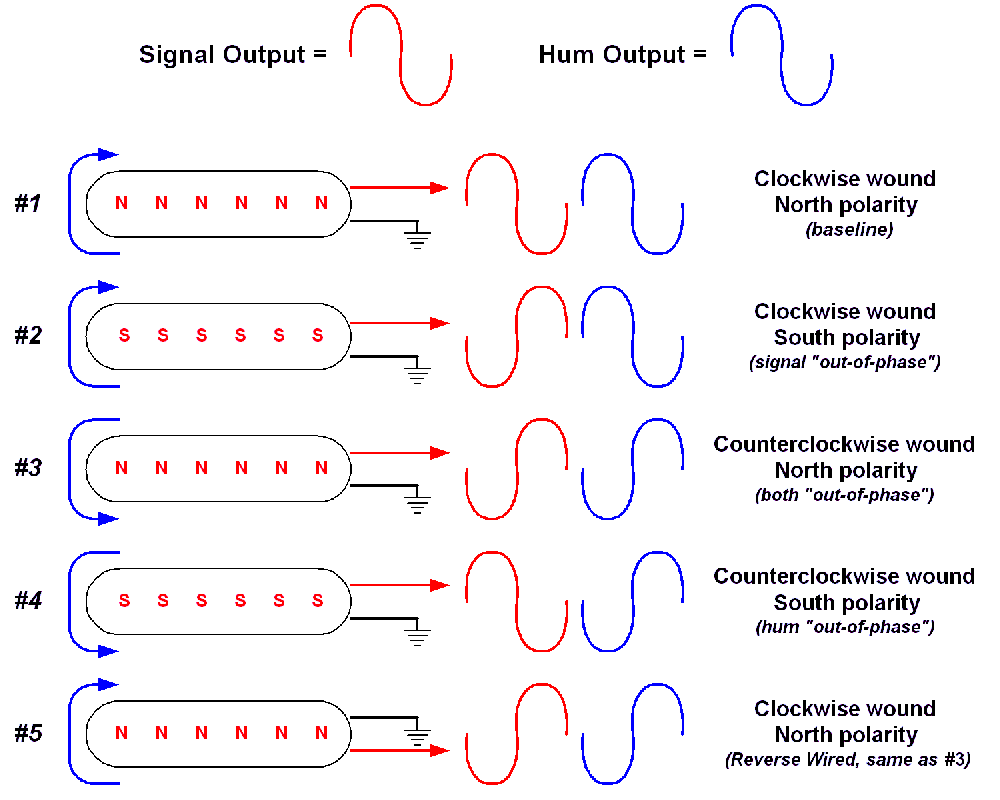| Author |
Message |
Steve (Gitfiddle1)
| | Posted on Thursday, April 12, 2001 - 7:41 pm: | |
Okay, John, you win. I have a feeling I'm gonna regret this.! Lol
Can you move my post from "What do you think of the Artist reissues?" concerning the humbucker wiring?
Let's make this an open forum for Q&A relating to repair and modification of guitar wiring/electronics.
Steve |
Steve (Gitfiddle1)
| | Posted on Thursday, April 12, 2001 - 4:39 pm: | |
Okay,
I'm probably gonna get some argument here, so let me start by offering my credentials. I have 6 years experience as an Electronic Technician in Uncle Sam's Navy plus another 3 in the civilian sector, and I have spent countless hours playing with guitar pickup wiring variations.
There is a common misconception that humbuckers cancel the 60Hz(cycle) noise by being wired "out-of-phase". This is not the case. I can explain how it works, but I'd rather not make the theory part of this post.
Standard humbucking mode is; SERIES and IN-PHASE.
The "parallel" mode is; PARALLEL and IN-PHASE
"Tapped", or single coil mode applies ground to the junction of the two coils. Thereby taking one out of the circuit.
If anybody doubts this, try wiring a humbucker "out-of-phase" and see what happens. You'll get virtually NO OUTPUT! Yeah, I know the "quiet" mode on a triple single deal has the middle pickup out of phase. This again gets into electrical theory. I ain't goin' there. Lol !!
If anybody wants the theory in-depth, please e-mail me. I don't wanna bore the hell out of the rest of the folks!
Cheers
Steve |
JohnS
| | Posted on Thursday, April 12, 2001 - 4:49 pm: | |
Steve:
I'd like to hear your explanation. I know what series and parallel mean. But what is "in-phase" and how does it relate to S & P. |
Gitfiddle1 (Gitfiddle1)
| | Posted on Thursday, December 06, 2001 - 1:59 pm: | |
Better late than never! I hope this diagram helps.
Cheers
Steve
 |
Aki.Rintamaki
| | Posted on Tuesday, December 11, 2001 - 8:20 am: | |
Two similiar pickups wired in series will not cancel any hum but sum everything together, as well as the hum. Two coils in a Humbucker have rewese polarities (and reverse wound) to make the hum cancelling.
Right?
-Aki. |
Evan
| | Posted on Wednesday, December 12, 2001 - 6:17 am: | |
While we're on the subject... does anyone know what the tri-sound switch on the older (late 70's, early 80's) AR and MC series does? I always thought it was series/parallel/phase, but have been told it's a parallel/tapped/series.
e
(hey Aki!) |
Gitfiddle1 (Gitfiddle1)
| | Posted on Wednesday, December 12, 2001 - 12:47 pm: | |
Yes Aki, you've basically got it right. However, it's a confusing deal because we have to look at the coil orientation, magnet polarity, and pickup placement at the same time. The diagram above only deals with the "signal" of the pickups.
A guitar pickup's primary job is to convert the movement (vibration) of the strings into an electrical signal. Unfortunately, the design of a typical pickup also creates two other non-desirable signals. These are "hum" and "microphonics". To make the explanation easier, lets look at the 3 processes involved.
Signal - This is the one we want. It is the product of the magnetic operation of the pickup. The strings moving in the magnetic field of the pickup induce a current in the windings of the coil(s)
Hum - This is created by the "antenna" effect of the coil(s). Electrical signals traveling through the air induce a current in the windings. This is primarily 60Hz (cycle) radiation from power sources.
Microphonics - This is the one where you can sing into your guitar, or tap on it, and hear it through your amp. This is caused by physical (mechanical) movement of the pickup components inducing a current in the windings.
Here's where things get a little complex. We want our pickup(s) to "see" the magnetic input and "ignore" the electrical and mechanical inputs.
The mechanical input (microphonics) is reduced by preventing the components (poles, baseplate, spools, windings, etc.) from moving in relation to each other. Wax potting and secure mounting of components usually takes care of the problem.
The electrical input (hum) can be reduced by shielding the conductive elements (windings, wires, pots, switches, etc.) from the air born signals. This is why you have conductive paint and aluminum or copper tape in your control & pickup cavities. Hum can also be reduced by canceling out the inputs (humbucking). If two pickup coils are "reversed" or "out-of-phase" with each other, the electrical inputs are mirror images of each other. They effectively cancel each other out.
However, if the coil windings are "reversed" or "out-of-phase", then the magnetic fields must also be "reversed" or "out-of-phase" if we are to maintain our signal.
Huh? See the diagram below.

Combinations of, 1 & 4, 2 & 3, or 2 & 5, will reduce noise in a "humbucker" configuration. In a triple-single (or dual single) configuration, 1 & 3 or 1 & 5 will also give "noiseless" operation but with a nasal "out-of-phase" tone. How's that?
When two pickup signals are combined "out-of-phase", the remaining output is the difference between the two signals. In a humbucker, the coils are close together and "see" basically the same input from the strings. Whereas in a triple single deal, the coils are spaced far enough apart that they "see" different harmonics on the strings. So when they are combined "out-of-phase" there is still a significant "difference" signal. This is true with any combination of neck/middle, middle/bridge, or neck/bridge. I have modified dual humbucker arrangements to have the signals out-of-phase in the middle position. This gives snarly midrange sound similar to the single coil out-of-phase arrangemant. A humbucker with the coil signals out-of-phase will have very little output signal regardless of whether they're wired in series or parallel.
So to answer Evan's question, the Ibanez "Tri-Sound" selections must be; Series, Parallel, Tapped.
Cheers
Steve |
Aki.Rintamaki
| | Posted on Wednesday, December 12, 2001 - 7:50 pm: | |
Steve:
I never actually knew why the hum cancelling works that way, but there we have it! I didn't realize that the hum in a regular wound pu will be out of phase with a RW/RP pu's hum..
We once spent hours of thinking about this with a friend of mine, but we never knew why it worked the way it did.. Thank You!
What about a HB with a Tri-Sound, will the hum be cancelled in the parallel mode? I once experimented a HB with a series-parallel switch, and I came to a conclusion that depending on how I wire the coils, either the parallel or the series connection will cancel the hum, but not both. The difference might have been a little one, so that both connections cancelled the hum, but some connections just did it better. Neither of the positions gave out-of-phase signal. Is this possible or was I too Young to hear things back then..?
Evan:
As in the (previously Your's :o) AR, the Tri-Sounds (as said above) are (from down to up) series - tapped - parallel. The MC has the Tri-Sounds in the same manner, ofcourse.
-Aki. |
|
|
Thank you for supporting Ibanez Collectors Forum. Please help your favorite Ibanez guitar site as we endeavor to bring you the latest information about Ibanez custom vintage electric and acoustic guitars. Here you can discuss ibanez, guitars, ibanez guitars, basses, acoustics, acoustic, mandolins, electric guitar, electric bass, amplifiers, effect pedals, tuners, picks, pickups.
|

